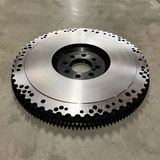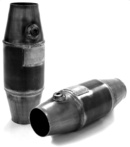Catalytic converter
Model More cells (300cell) gives better exhaust gas cleaning but poorer flow and more back pressure. Fewer cells (100cell) give poorer exhaust gas cleaning but better flow when tuning.
Connection Size of inlet and outlet. It can also be conical ends that stepless can be adjusted to different sizes to the exhaust system.
Products
Catalytic converter, Catalyst
What distinguishes 100 vs 200 vs 300 cells in a catalytic converter?
Cells are counted per inch.
Fewer cells = Better flow = Lower purification efficiency = Lower sound dampening
More cells = Reduced flow = Higher purification efficiency = Improved sound dampening
Sports Catalytic Converter vs. Racing Catalytic Converter?
Generally, 100 cells per inch is referred to as a racing catalytic converter. 200 and 300 cells per inch are typically called sports catalytic converters.
Choosing the size of the catalytic converter?
If there’s space, choose the largest body diameter possible for the catalytic converter to achieve the best flow performance.
Choosing the connection for the catalytic converter?
The most common type is converters with tapered ends for welding. There are also clamps available for fastening the converter.
Can a regular catalytic converter be used on diesel?
No, they are different types. A gasoline catalytic converter cannot be used with diesel engines.
Diesel Catalytic Converter (DOC - Diesel Oxidation Catalyst)
A diesel catalytic converter is designed to reduce harmful gases, such as carbon monoxide (CO), hydrocarbons (HC), and certain organic particulates found in diesel exhaust.
Diesel Particulate Filter (DPF - Diesel Particulate Filter)
A diesel particulate filter is specifically designed to capture and remove solid particles (soot) from the exhaust, which contribute to air pollution and pose health risks.
Cleaning the Diesel Particulate Filter
The filter is a physically porous structure with small channels that capture particles as the exhaust gases pass through. When the filter starts to fill up, it undergoes a regeneration process.
Passive Regeneration
The vehicle is driven for an extended period at higher engine speeds and temperatures (e.g., on a highway). Under these conditions, the exhaust gases reach a high enough temperature for the soot particles to burn off automatically.
Active Regeneration
The engine increases the temperature in the DPF by injecting extra fuel, which burns off the soot.


























































